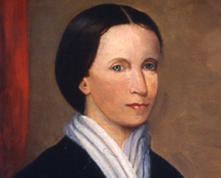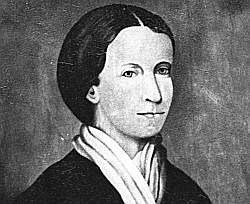Name Jane Swisshelm | Books Crusader and feminist | |
 | ||
Died July 22, 1884, Swissvale, Pennsylvania, United States | ||
Biography of jane swisshelm
Jane Grey Cannon Swisshelm (December 6, 1815 – July 22, 1884) was an American journalist, publisher, abolitionist, and women's rights advocate. She was active as a writer in Pittsburgh, Pennsylvania and as a publisher and editor in St. Cloud, Minnesota, where she founded a string of newspapers and regularly wrote for them.
Contents
- Biography of jane swisshelm
- Feb21 kiara jane swisshelm
- Early life and family
- Activism and newspaper writing
- Civil War years
- Later life and death
- References

While working for the federal government in Washington, D.C. during the administration of President Andrew Johnson, Swisshelm founded her last newspaper, Reconstructionist. Her published criticism of Johnson led to her losing her job and the closing of the paper. She published her autobiography in 1881.

Feb21 kiara jane swisshelm
Early life and family

Swisshelm was born Jane Grey Cannon in Pittsburgh, Pennsylvania, U.S., one of several children of Mary (Scott) and Thomas Cannon, both of Scotch-Irish descent; her father was a merchant and real estate speculator.

In 1823, when Jane was eight years of age, both her sister Mary and her father died of consumption, leaving the family in straitened circumstances. Jane worked at manual labor, doing lace making and painting on velvet, and her mother colored leghorn and straw hats. At twelve she was sent to boarding school for several weeks, as there were no public schools at the time. When she returned home, she learned the doctor thought she was in the first stage of consumption. Her mother had already lost four of her children to illnesses. She moved with her children to Wilkinsburg, a village outside Pittsburgh, and started a store. After some more formal study, in 1830, Jane started teaching classes for village children. That year her family learned that her older brother William, much loved by all, had died of yellow fever in New Orleans, where he had gone for work.
On November 18, 1836, at age 20, Cannon married James Swisshelm, from a nearby town. Jane was strong-willed, and her marriage was difficult. They moved to Louisville, Kentucky in 1838, where James intended to go into business with his brother Samuel. This is where Jane first encountered slavery, which made a strong impression on her. Nearby was a man who had sold away his own mixed-race children. She wrote in her autobiography of some of the sights she saw and stories she heard.
In 1839, against her husband's wishes, she moved to Philadelphia to care for her ailing mother. After her mother's death, she headed a girls' seminary in Butler, Pennsylvania. Two years later, she rejoined her husband on his farm, which she called Swissvale, east of Pittsburgh. (Today the area is Edgewood).
Activism and newspaper writing
During this time, Jane Swisshelm began writing articles against capital punishment, and stories, poems, and articles for an anti-slavery newspaper, the Spirit of Liberty, and others in Pittsburgh. Prompted by the demise of the Spirit of Liberty and the similarly themed Albatross, Swisshelm founded the newspaper Saturday Visiter [sic] in 1847. It eventually reached a national circulation of 6,000, and in 1854 was merged with the weekly edition of the Pittsburgh Commercial Journal. She wrote many editorials advocating women's property rights.
In 1857, she divorced her husband and moved west to St. Cloud, Minnesota, where she controlled a string of newspapers. She promoted abolition and women's rights by writing and lecturing. The city was a developing center of trade, located on the Mississippi in the central part of the eastern border of the state.
Writing in The Saint Cloud Visiter, Swisshelm waged a private war against Sylvanus Lowry, a Southern slaveholder and Indian trader who had settled in the area in 1847. Politically influential, he had been elected to the Territorial Council, and as the city's first mayor in 1856. By then he reigned as Saint Cloud's Democratic political boss. Swisshelm was especially infuriated that Lowry owned slaves, as Minnesota was a free state.
But, in 1857 the Supreme Court of the United States ruled in the Dred Scott case that slaves had no standing as citizens to file freedom suits, and that the Missouri Compromise was unconstitutional, so the state's prohibition against slavery could not be enforced. More Southerners migrated to St. Cloud and Minnesota with slaves. After the outbreak of the Civil War, most Southerners returned to the South, taking their slaves with them.
Writing in The Visiter, Swisshelm accused Lowry of swindling the local Winnebago as a trader, ordering vigilante attacks on suspected land claim jumpers, and abusing his slaves. He started a rival paper, The Union, later called the St. Cloud Times, to offset her influence.
After one of her fiery editorials, Lowry formed a "Committee of Vigilance", broke into the newspaper's offices, smashed the printing press, and threw the pieces into the nearby Mississippi River. Swisshelm soon raised money for another press and raised her attacks to a fever pitch. Formerly being groomed for the state post of Lieutenant Governor, Lowry saw his influence over Saint Cloud politics lessened but was elected to the state senate in 1862. He died young in 1865 in St. Cloud.
Civil War years
When Abraham Lincoln was nominated for the presidency, Swisshelm spoke and wrote in his behalf. When the American Civil War began and nurses were wanted at the front, she was one of the first to respond. After the Battle of the Wilderness, she had charge of 182 badly wounded men at Fredericksburg for five days, without surgeon or assistant, and saved them all.
In 1862, when a Sioux Indian uprising in Minnesota resulted in the deaths of hundreds of white settlers, Swisshelm was among those demanding the federal government punish the Indians. She toured major cities to raise public opinion about this issue and, while in Washington, D.C., met with Edwin M. Stanton, a friend from Pittsburgh and then Secretary of War. He offered her a clerkship in the government. She sold her Minnesota paper and continued to work as an army nurse during the Civil War in the Washington area until her job became available. She became a friend of Mary Todd Lincoln.
Later life and death
After the war, Swisshelm founded her final newspaper, the Reconstructionist. Her attacks on President Andrew Johnson led to her losing the paper and her government job. In 1872, she attended the Prohibition Party convention as a delegate.
As well as being a prolific journalist, Swisshelm published Letters to Country Girls (New York, 1853), and an autobiography entitled Half of a Century (1881).
Swisshelm died in 1884 at her Swissvale home and is buried in Allegheny Cemetery. The city of Pittsburgh neighborhood of Swisshelm Park, adjacent to Swissvale, is named in her honor.
